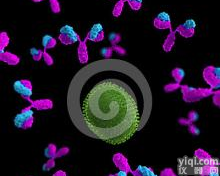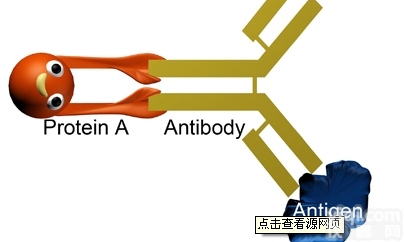产品名称:载脂蛋白B-mRNA编辑酶复合物3C抗体有货供应
中文名称:载脂蛋白B-mRNA编辑酶复合物3C抗体
英文名称:Anti-APOBEC3C
产品编号:byk-12495R
产品规格:0.1ml/0.2ml
产品用途:科研实验
亚 型: IgG
贮 存: 贮存于-20℃
抗体的异质性。抗体的组成极为复杂,是由成千上万、多种多样的免疫球蛋白(Ig)分子所组成。这些Ig分子在形状、大小、结构以及氨基酸的组成和排列上,既相似,又有差别。由于有差别,它们的电泳活性就有很大的变化。
载脂蛋白B-mRNA编辑酶复合物3C抗体有货供应 品说明:
APOBEC proteins inhibit retroviruses by deaminating cytosine residues of viral RNA and DNA. The seven APOBEC3 genes or pseudogenes are found in a cluster thought to result from gene duplication on chromosome 22. Like APOBEC3G, APOBEC3F deaminates deoxycytosine to deoxyuracil in the minus strand of HIV-1 DNA, resulting in G to A hypermutation in the plus strand of DNA. Thus, APOBEC3G and APOBEC3F provide a mechanism for innate immunity to retroviruses, and are also likely contribute to sequence variation observed in many viruses. Viral infectivity factor (Vif) imparts APOBEC3G and APOBEC3F resistance to HIV through impaired translation of their mRNA and accelerated posttranslational degradation of the APOBEC3 proteins by the 26S proteasome. Interestingly, HIV-1 Vif cannot form a complex with APOBEC3G or APOBEC3F of mouse origin as it does with the human protein, and thus mouse APOBEC3G and APOBEC3F function as a potent inhibitors of wildtype HIV-1 replication, where human APOBEC3G and APOBEC3F are only able to inhibit Vif-deficient HIV-1 replication. This implies that induction of APOBEC3G and APOBEC3F activity or a method of blocking their interaction with Vif may provide a method for therapeutic intervention.
保存条件:Store at -20 °C for one year. Avoid repeated freeze/thaw cycles. The lyophilized antibody is stable at room temperature for at least one month and for greater than a year when kept at -20°C. When reconstituted in sterile pH 7.4 0.01M PBS or diluent of antibody the antibody is stable for at least two weeks at 2-4 °C.
载脂蛋白B-mRNA编辑酶复合物3C抗体有货供应 关产品:
Anti-Menin/Men1 Menin抑癌蛋白抗体
Anti-Metal ion transporter 拟南介金属离子转运蛋白抗体
Anti-Mfn1 (Mitofusin1) 线粒体融合蛋白1抗体
Anti-MGMT (O6-methylguanine-DNA methyltransferase) O6甲基鸟嘌呤DNA甲基转移酶抗体
Anti-MT(metallothionein) 金属硫蛋白抗体
Anti-MGr1-Ag/37LRP(P37-kDa laminin receptor precursor)(NT) 层粘连蛋白受体1抗体(N端)
Anti-MTA1(Metastasis-associated 1) 肿瘤转移相关蛋白1抗体
Anti-MGr1-Ag/37LRP(P37-kDa laminin receptor precursor)(CT) 层粘连蛋白受体1抗体(C端)
Anti-Myf6(Myogenic factor 6) 生肌调节因子6抗体
Anti-MGr1-Ag monoclonal antibody(laminin receptor 1; 67kD, ribosomal protein SA) 小鼠抗层粘连蛋白受体1单克隆抗体
抗体结构:
抗体是具有4条多肽链的对称结构,其中2条较长、相对分子量较大的相同的重链(H链);2条较短、相对分子量较小的相同的轻链(L链)。链间由二硫键和非共价键联结形成一个由4条多肽链构成的单体分子。轻链有κ和λ两种,重链有μ、δ、γ、ε和α五种。 整个抗体分子可分为恒定区和可变区两部分。在给定的物种中,不同抗体分子的恒定区都具有相同的或几乎相同的氨基酸序列。可变区位于"Y"的两臂末端。在可变区内有一小部分氨基酸残基变化特别强烈,这些氨基酸的残基组成和排列顺序更易发生变异区域称高变区。高变区位于分子表面,多由17个氨基酸残基构成,少则只有2 ~ 3个。高变区氨基酸序列决定了该抗体结合抗原抗原的特异性。一个抗体分子上的两个抗原结合部位是相同的,位于两臂末端称抗原结合片段(antigen-binding fragment, Fab)。"Y"的柄部称结晶片段(crystalline fragment,FC),糖结合在FC 上。
 载脂蛋白B-mRNA编辑酶复合物3C抗体,Anti-APOBEC3C抗体
载脂蛋白B-mRNA编辑酶复合物3C抗体,Anti-APOBEC3C抗体
 载脂蛋白B-mRNA编辑酶复合物3C / 载脂蛋白B-mRNA编辑酶复合物3C抗体
载脂蛋白B-mRNA编辑酶复合物3C / 载脂蛋白B-mRNA编辑酶复合物3C抗体
 载脂蛋白B-mRNA编辑酶复合物3B / 载脂蛋白B-mRNA编辑酶复合物3B抗体
载脂蛋白B-mRNA编辑酶复合物3B / 载脂蛋白B-mRNA编辑酶复合物3B抗体
 载脂蛋白B-mRNA编辑酶复合物2 / 载脂蛋白B-mRNA编辑酶复合物2抗体
载脂蛋白B-mRNA编辑酶复合物2 / 载脂蛋白B-mRNA编辑酶复合物2抗体
 载脂蛋白B-mRNA编辑酶复合物1 / 载脂蛋白B-mRNA编辑酶复合物1抗体
载脂蛋白B-mRNA编辑酶复合物1 / 载脂蛋白B-mRNA编辑酶复合物1抗体
 Anti-NETO1抗体,脑低密度脂蛋白受体蛋白1抗体价格
Anti-NETO1抗体,脑低密度脂蛋白受体蛋白1抗体价格
 Anti-NETO1抗体,脑低密度脂蛋白受体蛋白1抗体价格
Anti-NETO1抗体,脑低密度脂蛋白受体蛋白1抗体价格
 Biotin 标记NETO1抗体,脑低密度脂蛋白受体蛋白1抗体
Biotin 标记NETO1抗体,脑低密度脂蛋白受体蛋白1抗体
 NETO1抗体,脑低密度脂蛋白受体蛋白1抗体FITC.PE
NETO1抗体,脑低密度脂蛋白受体蛋白1抗体FITC.PE
 Anti-NETO1抗体 脑低密度脂蛋白受体蛋白1抗体
Anti-NETO1抗体 脑低密度脂蛋白受体蛋白1抗体
 Anti-NETO1抗体 脑低密度脂蛋白受体蛋白1抗体
Anti-NETO1抗体 脑低密度脂蛋白受体蛋白1抗体
 Anti-NETO1抗体 脑低密度脂蛋白受体蛋白1抗体
Anti-NETO1抗体 脑低密度脂蛋白受体蛋白1抗体